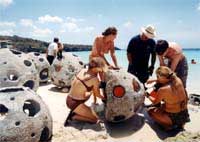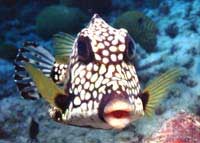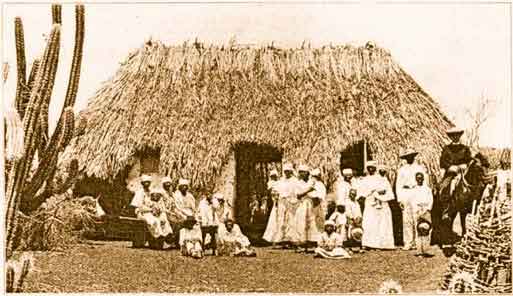| Environment-friendly techniques for
scuba-diving and snorkelling
PortoMari’s
Past
Reefballs
A
first for Curaçao
 Have you
been to Playa PortoMari lately? If so, you will have noticed an inordinate
amount of activity going on. Difficulty parking your car? So sorry, but it
is all in a good cause - our Reefball Research Project. Maybe you have
read about it already because Curaçao's local newspapers have taken great
interest in our innovative approach to promote coral regeneration around
the coast and on our reef in particular. Hurricane Lenny caused
considerable damage to our "double" reef in November 1999. The first reef,
the one that is in the shallow water and accessible from the shore, was
the main victim and that is where we are concentrating our recovery
efforts. Although Reefballs have been used in other countries, this is a
first for Curaçao. Under the guidance of two American specialists, Todd
Barber and Larry Beggs, and our own marine biologist, Maureen Kuenen, some
twelve volunteers have been constructing concrete reefballs that are being
placed in strategic locations to encourage new coral growth and provide
shelter and breeding places for other reef inhabitants. Want to know more
about reefballs? The Reef Ball Foundation in America has an interesting
website: http://www.reefball.org/ Have you
been to Playa PortoMari lately? If so, you will have noticed an inordinate
amount of activity going on. Difficulty parking your car? So sorry, but it
is all in a good cause - our Reefball Research Project. Maybe you have
read about it already because Curaçao's local newspapers have taken great
interest in our innovative approach to promote coral regeneration around
the coast and on our reef in particular. Hurricane Lenny caused
considerable damage to our "double" reef in November 1999. The first reef,
the one that is in the shallow water and accessible from the shore, was
the main victim and that is where we are concentrating our recovery
efforts. Although Reefballs have been used in other countries, this is a
first for Curaçao. Under the guidance of two American specialists, Todd
Barber and Larry Beggs, and our own marine biologist, Maureen Kuenen, some
twelve volunteers have been constructing concrete reefballs that are being
placed in strategic locations to encourage new coral growth and provide
shelter and breeding places for other reef inhabitants. Want to know more
about reefballs? The Reef Ball Foundation in America has an interesting
website: http://www.reefball.org/
Environment-friendly techniques for scuba-diving and
snorkelling
 Although Plantages "PortoMari" tries to do everything to make
scuba-diving and snorkelling as attractive as possible, we need your
cooperation to help protect and preserve our underwater treasures. Although Plantages "PortoMari" tries to do everything to make
scuba-diving and snorkelling as attractive as possible, we need your
cooperation to help protect and preserve our underwater treasures.
The
Diver's/Snorkeller's Eight Commandments
- Maintain good control of
your buoyancy. Divers often inadvertently bump against coral which then
becomes diseased and dies. If you are an inexperienced diver, keep a
reasonable distance (2m).
- Use a good swimming
technique. Do not let your fins drag along the ocean floor and disturb
the sand. Loose sand forms a deposit on coral that is life-threatening
to these organisms.
- Make sure that loose
equipment does not damage any of the underwater organisms.
- Avoid contact with the
ocean floor and its sea creatures. Contact with them is dangerous for
you as well as for them.
- Do not remove anything
from the ocean floor, not even to show other people on the beach. But
please help us by removing trash, like cans and plastic cups - they do
not belong there.
- Wearing gloves under water
encourages you to touch things. DO NOT TOUCH ANYTHING.
- Spearfishing is illegal.
- If you see or come close
to our "Reefballs", please keep your distance and do not disturb them.
Plantages
"PortoMari" wishes you happy diving &
snorkelling.
PortoMari’s Past

A fascinating
history
Plantages PortoMari, which
covers an area of 594 hectares, has a history that goes back to 1684. In
that year, Puerto Marie was given permission to create enclosures for
cows, sheep and goats. Without this permit, the owner was not allowed to
raise livestock. The landhouse (or country house) was built in the second
half of the 18th century, but in the nineteen- thirties it was struck by
lightning and burnt to the ground.
In the 18th century, a
fortification was built on the top of Seru Caballé. This post was rebuilt
in 1742 as Fort Porto Mari and it had ten cannons, both 12 and 18
pounders. When in 1805 the English captured the neglected fort, it still
had 19 cannon balls and one 12-pound cannon, which the invaders proceeded
to throw into the sea to render the fort harmless.
PortoMari played an important
role in the slave uprising of 1795. It was here that the slaves gathered
and the famous discussion took place between Tula and Pastor Schinck.
Fierce fighting during which many rebellious slaves were killed followed
this meeting.
About 200 slaves and freed
slaves used to live on the plantation. They raised livestock, cultivated
maize, grew fruit and vegetables in the orchard near the landhouse, made
charcoal and tended the limestone ovens. After emancipation in 1863, most
of the freed slaves continued to live on the Plantation.
Footprints
2001/1
“Un journal c’est un
monsieur”
Water Management at PortoMari - Where every drop of water
counts
Reefballs - A first for
Curaçao
Plantages "PortoMari" - 7 years from now ...
A Glimpse into
the Future
Playa
PortoMari - then and now by Ingrid Lochem
Environment-friendly techniques for scuba-diving and
snorkelling
PortoMari's Past - A fascinating
history
<Back | 
